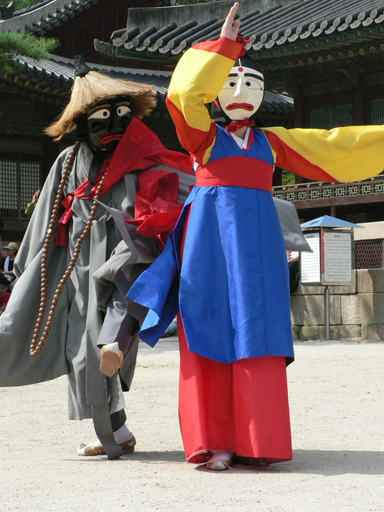- Songpa sandaenori
Infobox Korean name

imgwidth=200
caption=
hangul=송파산대놀이
hanja=松坡山臺놀이
rr=Songpa sandae nori
mr=Songp'a santae noriThe Songpa sandaenori is a type of "talchum ", Korean traditionalmask play which has been handed down in the neighborhoods ofSongpa-dong cite web|url=http://www.maskdance.com/2002/english/sub3/body2_8.htm |title=Songpasandae maskdance |publisher=Andong MaskDance Festival] andGarak-dong in modern-day Seoul, South Korea. "Sandaenori" is a mask dance that developed in Seoul and the the mid of metropolitan region.cite web|url=http://english.nyj.go.kr/Tourism/Toegyewon.html |title=Toegyewon Sandaenori |publisher=Namyangju City] cite web|url=http://100.empas.com/dicsearch/pentry.html?s=K&i=238738&v=46 |title=송파산대놀이 (松坡山臺──)|publisher=Empas /EncyKorea |language=Korean]History
The "Songpa sandaenori" began with a cheerful parade called "georigut" (거리굿) or "gilnori" (길놀이) as circling around the Songpa Market and nearby town in order to attract people to their performance. The two terms literally mean "street shamanistic ritual" and "street performanace" respectively. When parading, they wore a prepared mask and costume, and played a type of marching music, "gilgunak" (길군악)cite web|url=http://enc.daum.net/dic100/contents.do?query1=b03g1355a |title=길군악 (한국 음악) ── 軍樂, 노요곡|publisher=
Daum /Britannica |language=Korean] . With a decorative small flag used by farmers or "yeonggi" (영기, 令旗)cite web|url=http://100.empas.com/dicsearch/pentry.html?i=287199 |title=영기 (令旗)|publisher=Empas /EncyKorea |language=Korean] cite web|url=http://100.empas.com/dicsearch/pentry.html?s=B&i=158580&v=46 |title=송파산대놀이 (松坡山臺──) |publisher=Empas /Britannica |language=Korean] at the head, the performers followed the musicians in procession. After the parade, they used anamulet to ward off misfortune and to wish everyone in the market to have good health and fortune.cite web|url=http://www.arirang.co.kr/Tv2/ALegacy_Archive.asp?PROG_CODE=TVCR0301&view_cont_seq=10&code=St1&sys_lang=Eng |title=Songpa Sandaenori (Songpa Mask Dance Drama) |publisher=Arirang TV |date=2007-09-08]Preparation
The performers hold a "seomakgosa" (서막고사), a kind of "
jesa ", sacrificial rite before the "sandaenori" begins. Masks used for the coming performance are placed on a table setting for the "jesa" along with several varieties of food, and performers pour alcoholic beverages into a bowl and bow toward the table. This rite is to honor the dead and wish them to rest in peace, as well as to expect to have a good performance.Story
It consists of 7 acts called "gwajang" (과장, 科場) or "madang" (마당) in Korean. The "Songpa sandaenori" candidly depicts conflicts between classes and human nature with a tightly-woven story.
Cultural significance
It is designated as the No. 49,
Important Intangible Cultural Properties by South Korea.cite web|url=http://100.empas.com/dicsearch/pentry.html?s=B&i=158580&v=46 |title=송파산대놀이 (松坡山臺──) |publisher=Empas /Britannica |language=Korean]Gallery
ee also
*
Talchum
*Namsadang nori
*Important Intangible Cultural Properties References
*cite web|url=http://sca.visitseoul.net/korean/ethnic/i_intangible_properties06024.htm |title=송파산대놀이 (松坡山臺놀이) |publisher=Seoul Cultural Affairs Division,
Seoul Metropolitan Government |language=Korean
*cite web|url=http://www.tal.or.kr/coding/english/sub08.asp |title=Korean masks |publisher=Hahoe Mask MuseumExternal links
* [http://sca.visitseoul.net/jsp/sca/english/ethnic/i_intangible_properties.jsp?num=06024 Information and video clip on Songpasandaenori] ,
Seoul Metropolitan Government
Wikimedia Foundation. 2010.
